Nicole schreibt...
Luxembourg 2017 |
 |
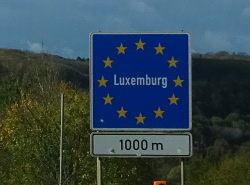 So near and yet so far... the tiny Grand Duchy of Luxembourg lies in the heart of Europe and yet goes widely ignored by tourism and the media unless it's about tax-dodging corporations or the only somewhat famous Luxembourger opening his mouth to reveal once more how out of touch with the real world the EU-leaders are. Hands up if you know the name of the current Grand Duke of Luxembourg though... yeah, I thought so.
So near and yet so far... the tiny Grand Duchy of Luxembourg lies in the heart of Europe and yet goes widely ignored by tourism and the media unless it's about tax-dodging corporations or the only somewhat famous Luxembourger opening his mouth to reveal once more how out of touch with the real world the EU-leaders are. Hands up if you know the name of the current Grand Duke of Luxembourg though... yeah, I thought so.
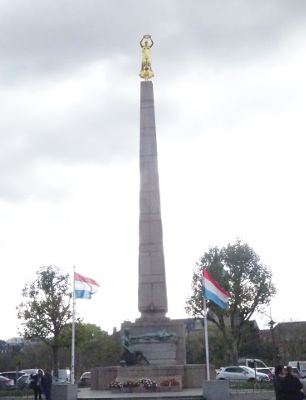 Actually I had been to Luxembourg many years ago on one of those ill-conceived ham-fisted class trips our school excelled at, though I couldn't remember anything about it anymore except the mind-numbing boredom of visiting a hydro-electric power plant, catching a quick look at Luxembourg-City's sights like the Gëlle Fra (she on the right) from a bus window and spending almost all of the free time in some dodgy little shop that flogged trite a-ha merchandise (the boyband of our day which my companions were crazy about). So, after some years of thinking that it would be really rather nice to visit Luxembourg properly, I was finally off on the tail end of decent autumn weather.
Actually I had been to Luxembourg many years ago on one of those ill-conceived ham-fisted class trips our school excelled at, though I couldn't remember anything about it anymore except the mind-numbing boredom of visiting a hydro-electric power plant, catching a quick look at Luxembourg-City's sights like the Gëlle Fra (she on the right) from a bus window and spending almost all of the free time in some dodgy little shop that flogged trite a-ha merchandise (the boyband of our day which my companions were crazy about). So, after some years of thinking that it would be really rather nice to visit Luxembourg properly, I was finally off on the tail end of decent autumn weather.Since hotel parking costs a leg and a half and there isn't that much to see and do in Luxembourg-City to begin with, we opted for a hotel at the fringes of town, the lovely Alvisse Parc Hotel which is aimed more at business travellers and conferences and had lots of free parking available, a big spa area and a bus stop right at the door. So after arriving, we took the bus into the city, had a late lunch in one of the nice restaurants on central Place d'Armes before going for a first walk. Which led me back to the Gëlle Fra, the "Golden lady", a war memorial for the Luxembourgians who died in both world wars and (oddly enough) in the Korean war. Her first incarnation was set up after World War I, then torn down by the Nazis and later set up again, although the actual golden lady was missing until 1980, when she turned up in the football stadium (!). Here she is again in close-up next to the other lady in the city, the Cathedral Notre Dame:
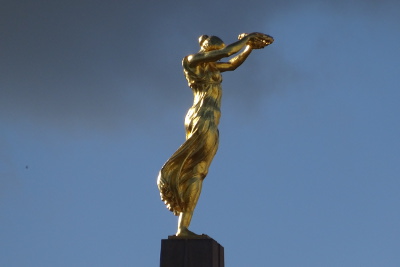
|
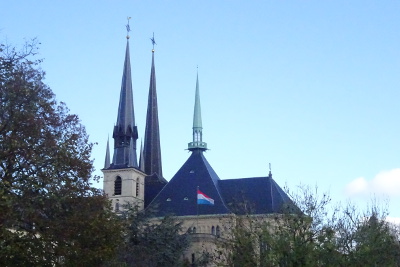 |
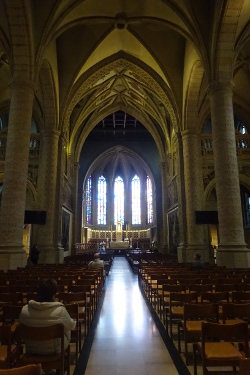 |
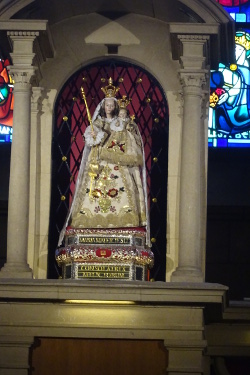 |
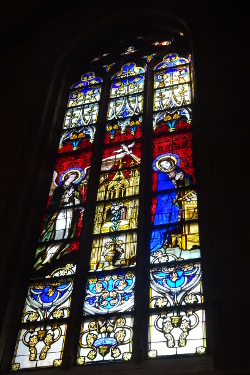 |
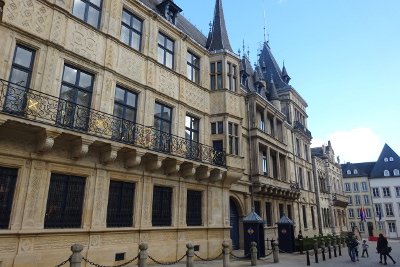 Last stop in the city was the Grand Ducal Palace, which started life as Luxembourg's city hall from 16th to 18th century. During the reshuffling of Europe at the Vienna Congress the Grand-Duchy of Luxembourg fell into the House of Nassau's (the Dutch monarchy) lap who installed one of their princes at the pretty building. Not until 1890 did Luxembourg get their proper own monarchs (don't ask, it's complicated) who expanded the palace to make it properly theirs. While the building is only used for official functions these days, it's out of bounds for tourists.
So we took a photo, moved on and ended our stroll back at the Place d'Armes for coffee, then back to the hotel to spend the rest of the day in the lovely spa with pool and sauna.
Last stop in the city was the Grand Ducal Palace, which started life as Luxembourg's city hall from 16th to 18th century. During the reshuffling of Europe at the Vienna Congress the Grand-Duchy of Luxembourg fell into the House of Nassau's (the Dutch monarchy) lap who installed one of their princes at the pretty building. Not until 1890 did Luxembourg get their proper own monarchs (don't ask, it's complicated) who expanded the palace to make it properly theirs. While the building is only used for official functions these days, it's out of bounds for tourists.
So we took a photo, moved on and ended our stroll back at the Place d'Armes for coffee, then back to the hotel to spend the rest of the day in the lovely spa with pool and sauna.
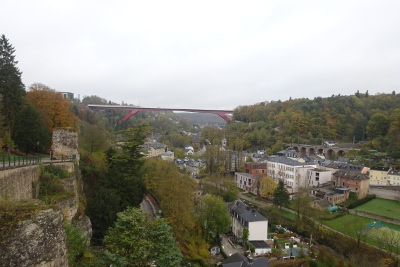 Next morning the sightseeing tour started in earnest which in Luxembourg basically means an awful lot of up and down. The first villages were built in the deep valley, where the Petrusse meets the bigger Alzette, which curves in a very deep S-shaped double bend. This here is the view to the North and the village of Pfaffenthal in the valley (with the Grand Duchess Charlotte-Bridge forming the crossing between the City and the Kirchberg, where they created the EU quarters in the 50s. Also on the Kirchberg is Fort Thüngen (also known as Fort Dräi Eechelen, Three Acorns), one of the last remaining bits of the massive Fortress that once encompassed the entire city centre. Historic tidbit: The Luxembourgians were asked in 19th century whether they wanted to belong to France, Germany or Belgium and basically just went nope to all of it (understandably). But in order to remain an independent Grand Duchy they had to agree to strict neutrality and this meant tearing down about 24 kilometres of fortress walls and become an "open city" in 1867. Which is now also the title of the very interesting exhibition inside the fortress museum, that made the slog from the city down to the Alzette and back up worthwhile.
Next morning the sightseeing tour started in earnest which in Luxembourg basically means an awful lot of up and down. The first villages were built in the deep valley, where the Petrusse meets the bigger Alzette, which curves in a very deep S-shaped double bend. This here is the view to the North and the village of Pfaffenthal in the valley (with the Grand Duchess Charlotte-Bridge forming the crossing between the City and the Kirchberg, where they created the EU quarters in the 50s. Also on the Kirchberg is Fort Thüngen (also known as Fort Dräi Eechelen, Three Acorns), one of the last remaining bits of the massive Fortress that once encompassed the entire city centre. Historic tidbit: The Luxembourgians were asked in 19th century whether they wanted to belong to France, Germany or Belgium and basically just went nope to all of it (understandably). But in order to remain an independent Grand Duchy they had to agree to strict neutrality and this meant tearing down about 24 kilometres of fortress walls and become an "open city" in 1867. Which is now also the title of the very interesting exhibition inside the fortress museum, that made the slog from the city down to the Alzette and back up worthwhile.
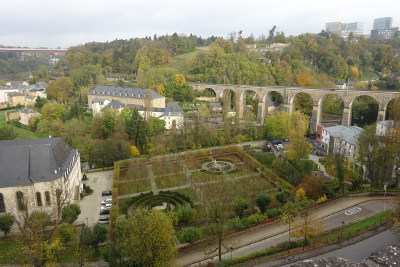
|
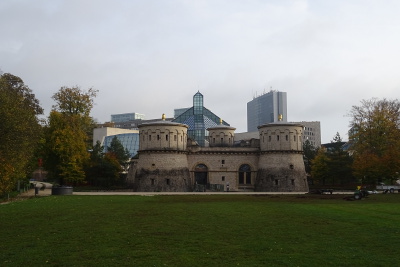 |
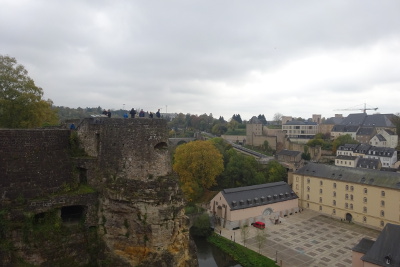
|
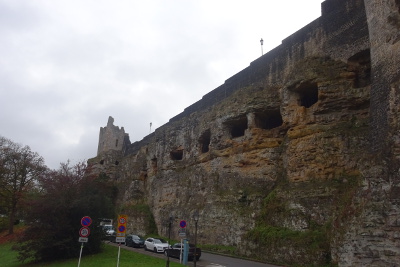 |
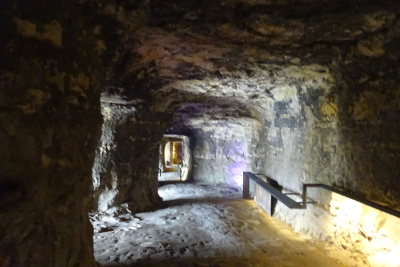 During World War II the casemates were used by civilians seeking shelters and nowadays they are pretty much Luxembourg's tourist attraction no.1, where you can go underground and wander through (some) of the ancient passages.
You emerge from them on the Corniche, also called Luxembourg's balcony for the fine view it offers over the village of Grund. Below left is church of Neumünster Abbey and the "Stierchen" (Little Bull), the first bridge across the Alzette and the view across Grund to the other side:
During World War II the casemates were used by civilians seeking shelters and nowadays they are pretty much Luxembourg's tourist attraction no.1, where you can go underground and wander through (some) of the ancient passages.
You emerge from them on the Corniche, also called Luxembourg's balcony for the fine view it offers over the village of Grund. Below left is church of Neumünster Abbey and the "Stierchen" (Little Bull), the first bridge across the Alzette and the view across Grund to the other side:
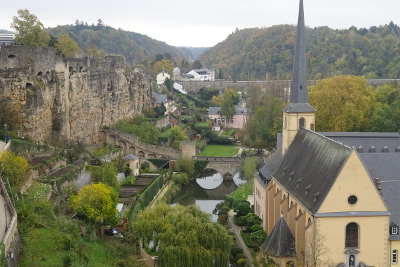
|
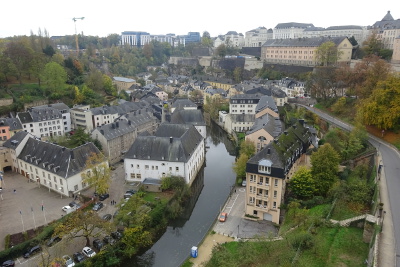 |
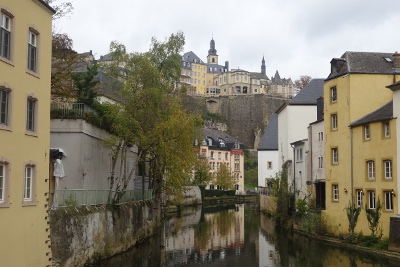
|
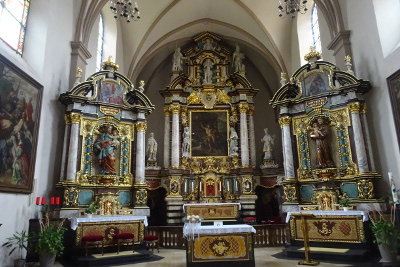 |
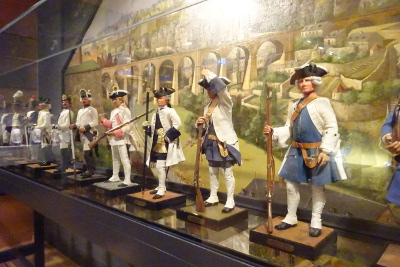 Last stop on the tour was the City Museum beside the Grand Ducal Palace that describes 1000 years of city history from the first fortification on the Bock and the small villages in the valley to today's sprawl with entirely new quarters as well as the development of the Luxembourgian economy (We have butter! we have mustard! We have... ummm, okay, we have that at least!).
It was definitely interesting as Luxembourg feels like a place one should know but doesn't really and it took me more than one big city model to put the Alzette valley with its bends, the Petrusse valley, the bridges and various areas into context. Luxembourg-City is certainly not on par with other European capitals like Paris, London or even Brussels, but it's definitely a town worth seeing - and there is lots more to see beyond the city, too.
Last stop on the tour was the City Museum beside the Grand Ducal Palace that describes 1000 years of city history from the first fortification on the Bock and the small villages in the valley to today's sprawl with entirely new quarters as well as the development of the Luxembourgian economy (We have butter! we have mustard! We have... ummm, okay, we have that at least!).
It was definitely interesting as Luxembourg feels like a place one should know but doesn't really and it took me more than one big city model to put the Alzette valley with its bends, the Petrusse valley, the bridges and various areas into context. Luxembourg-City is certainly not on par with other European capitals like Paris, London or even Brussels, but it's definitely a town worth seeing - and there is lots more to see beyond the city, too.
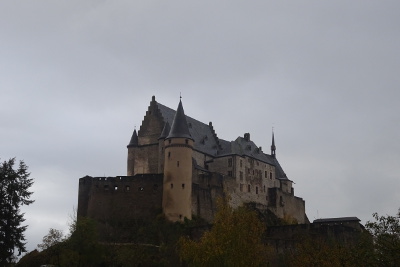 This beauty here for example, the mighty Chateau of Vianden. One of the things I forever failed to get my head around was how our teachers could have decided to make us visit the hydro-electric power plant in Vianden but ignore the amazing castle back then.
The castle (an UNESCO world heritage site, by the way, just like Luxembourg-City) was first built as a Roman Castellum, then later expanded and by 1090 the first Count of Vianden was mentioned in writing. In 1820 the long abandoned castle was sold to a local guy who started to dismantle it, sold what was valuable and left the rest to fall to ruins. Which at least pissed off the Luxembourgian rulers so much that they bought it back and started restoration works. Revolutions, wars and money shortages interrupted and the castle was not completed until 1986 (which, incidentally, was the year of our class trip, so MAYBE we didn't visit the castle because it wasn't open yet!). Anyway, for fans of medieval stuff, the carefully restored castle is an utter joy to walk through, giving a vivid idea what things would have looked like:
This beauty here for example, the mighty Chateau of Vianden. One of the things I forever failed to get my head around was how our teachers could have decided to make us visit the hydro-electric power plant in Vianden but ignore the amazing castle back then.
The castle (an UNESCO world heritage site, by the way, just like Luxembourg-City) was first built as a Roman Castellum, then later expanded and by 1090 the first Count of Vianden was mentioned in writing. In 1820 the long abandoned castle was sold to a local guy who started to dismantle it, sold what was valuable and left the rest to fall to ruins. Which at least pissed off the Luxembourgian rulers so much that they bought it back and started restoration works. Revolutions, wars and money shortages interrupted and the castle was not completed until 1986 (which, incidentally, was the year of our class trip, so MAYBE we didn't visit the castle because it wasn't open yet!). Anyway, for fans of medieval stuff, the carefully restored castle is an utter joy to walk through, giving a vivid idea what things would have looked like:
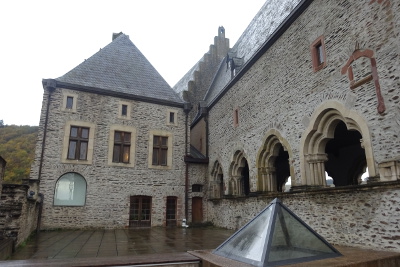
|
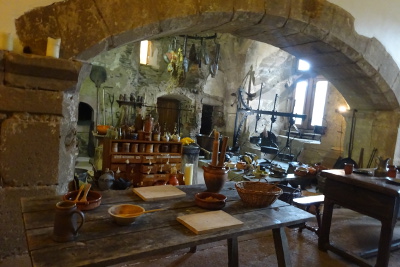 |
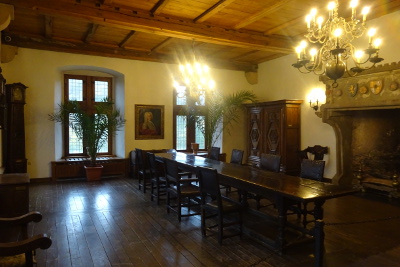
|
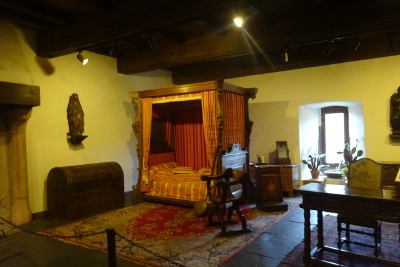 |
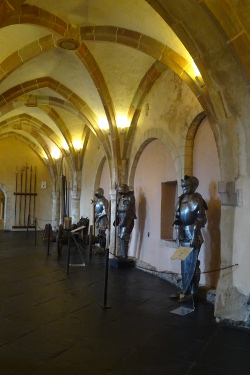 |
 |
 |
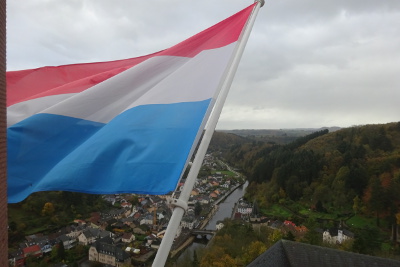 Here's the view from the castle across the village and the Our valley. While the "circuit" takes only an hour or so, it was definitely very much worth the detour on the way home from Luxembourg. All in all a very lovely short trip full of great historical stuff, good food and relaxation, just what I needed.
This should also have been the last adventure for this year, but another one is follow next month...
Here's the view from the castle across the village and the Our valley. While the "circuit" takes only an hour or so, it was definitely very much worth the detour on the way home from Luxembourg. All in all a very lovely short trip full of great historical stuff, good food and relaxation, just what I needed.
This should also have been the last adventure for this year, but another one is follow next month...
Copyright © All Rights Reserved